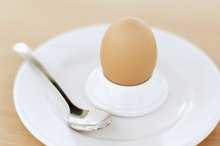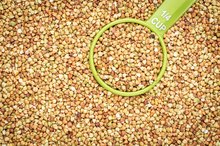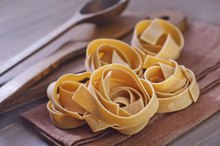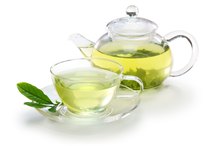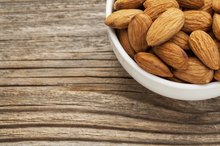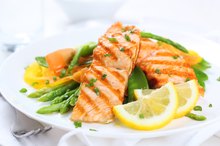How to Cut Out Carbs to Lose Body Fat
The best way to lose fat is through a combination of dietary changes and exercise. You need to cut 500 to 1,000 calories per day to lose 1 to 2 pounds a week. Limiting your carbs may make it easier for you to cut calories and lose weight, but you shouldn't eliminate them all. Some carbohydrate-containing foods, such as fruits and nonstarchy vegetables, are actually beneficial for weight loss. The key is to cut out the less healthy sources of carbs while increasing your lean protein intake. Speak with your doctor before starting any new diet or exercise program to make sure it is safe for you.
Importance of Carbs During Weight Loss
Carbs are one of the main sources of energy for your body, and they also provide fiber. Fiber-rich foods, such as fruits, vegetables, whole grains and legumes, help limit your disease risk and may also fill you up so you eat fewer calories overall. Fruits and non-starchy vegetables, such as broccoli, lettuce, cabbage, carrots and bell peppers, are particularly beneficial for weight loss because they're very filling but don't contain many calories per serving. Eating them at the beginning of your meal can help fill you up so you don't eat as much of the higher calorie foods on your plate, making it easier to cut calories and lose weight.
Percentage of Carbs to Include
Can Eating 30 Grams of Protein Each Morning Help You Lose Weight?
Learn More
The Institute of Medicine recommends getting between 45 and 65 percent of your calories from carbohydrates, 10 to 35 percent from protein, and 20 to 35 percent from fat. Reducing the carbs you eat, while increasing protein, may help you lose weight and improve your body composition, according to a study published in The Journal of Nutrition in 2003. Thus, a mix of about 45 percent carbohydrates, 30 percent protein and 25 percent fat may be helpful for losing weight. If you eat 1,500 calories a day, that gives you about 170 grams of carbs, 112 grams of protein, 42 grams of fat.
If keeping track of these nutrients is a bit much for you, a simpler way to get a good mix of lean protein, healthy carbs and fat is to divide your plate into quarters, one section each for fruits, non-starchy vegetables, whole grains and lean protein foods.
Choosing the Right Carbs to Cut
When you're trying to lose weight, get your carbohydrates mainly from non-starchy vegetables, legumes, fruits and whole grains. Cut carbs by eating fewer sweets, processed foods and refined grains, and drinking fewer sugary beverages. For example, trade soda for water, unsweetened tea or coffee; have fruit instead of cake or ice cream for dessert; and swap white rice for brown rice or quinoa. People who ate more fruits and vegetables were able to increase their weight loss as reported in a study published in The American Journal of Clinical Nutrition in 2009. These foods are also excellent sources of essential nutrients, unlike sweets and sugary foods.
Importance of Protein for Losing Body Fat
Exercises to Slim Hips, Thighs & Stomach
Learn More
Eating at least 25 to 30 grams of protein per meal may help increase your weight loss results and help you feel less hungry, according to a review article published in The American Journal of Clinical Nutrition in 2015. High-protein diets are also better for losing body fat than those with a standard amount of protein, notes the results of a study published in Nutrition, Metabolism & Cardiovascular Diseases in 2009.
Choose a mix of lean protein sources, such as seafood, legumes, skinless poultry and less-fattening cuts of pork and beef: those with "loin" or "round" in the name. You can get the recommended 25 to 30 grams of protein per meal by eating 3 ounces of lean beef, an ounce of non-fat mozzarella along with 3 ounces of chicken breast, or a cup of quinoa with a cup of lentils.
Don't Forget to Exercise
To maximize the fat-loss potential of your dietary changes, you also need to exercise. Combining the recommended reduced-calorie, high-protein diet with resistance training will help increase your weight and fat loss, according to a study published in Diabetes Care in 2010. Resistance training includes lifting weights and body-weight exercises, such as squats, sit-ups and push-ups. You also want to include cardio in your weight-loss plan, such as running, swimming, brisk walking or even dancing to your favorite music. The cardio helps increase the beneficial effects of the protein in your diet and maximizes weight loss and fat loss while minimizing the amount of muscle you lose. For weight loss, aim for at least 300 minutes of cardio and two sessions of resistance training per week.
Related Articles
References
- Rush University Medical Center: Should You Cut Out Carbs and Pack on the Protein?
- NHS Choices: The Truth About Carbs
- HealthAliciousNess.com: The Top 10 High Protein Foods
- The Journal of Nutrition: A Reduced Ratio of Dietary Carbohydrate to Protein Improves Body Composition and Blood Lipid Profiles During Weight Loss in Adult Women
- The American Journal of Clinical Nutrition: The Role of Protein in Weight Loss and Maintenance
- Nutrition, Metabolism and Cardiovascular Diseases: High Protein Diets Decrease Total and Abdominal Fat and Improve CVD Risk Profile in Overweight and Obese Men and Women With Elevated Triacylglycerol
- Diabetes Care: A High-Protein Diet With Resistance Exercise Training Improves Weight Loss and Body Composition in Overweight and Obese Patients With Type 2 Diabetes
- The Journal of Nutrition: Dietary Protein and Exercise Have Additive Effects on Body Composition During Weight Loss in Adult Women
Resources
- Institute of Medicine: Dietary Reference Intakes: Macronutrients
- Drugs.com: Exercise for Weight Loss: Calories Burned in 1 Hour
- The American Journal of Clinical Nutrition: Fruit and Vegetable Intakes and Subsequent Changes in Body Weight in European Populations: Results From the Project on Diet, Obesity, and Genes (DiOGenes)
Writer Bio
Based in Massachusetts, Jessica Bruso has been writing since 2008. She holds a master of science degree in food policy and applied nutrition and a bachelor of arts degree in international relations, both from Tufts University.
